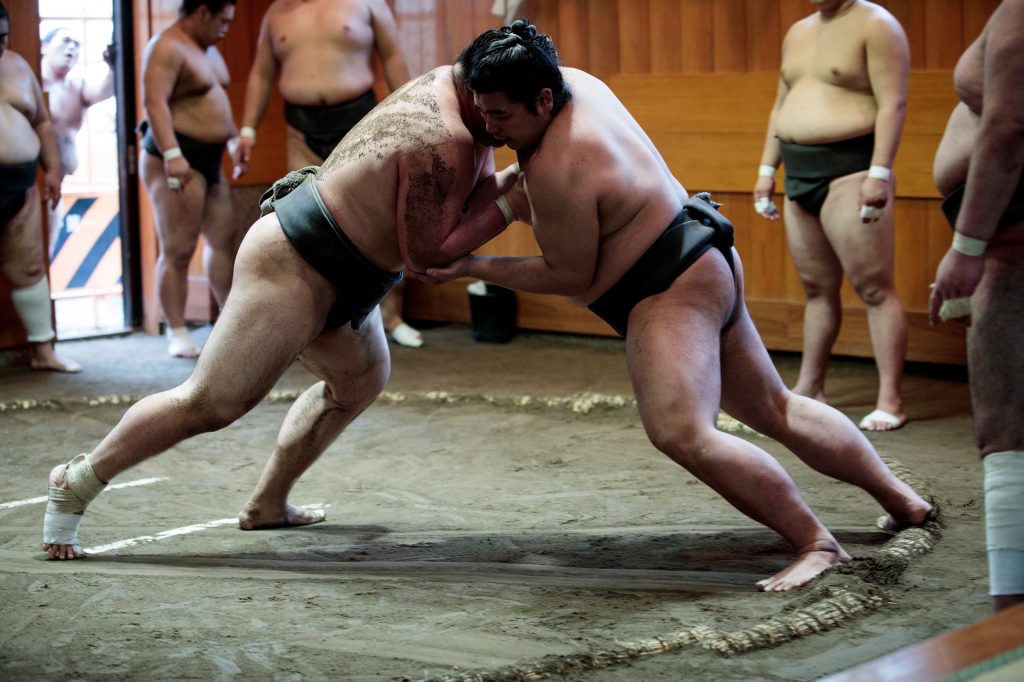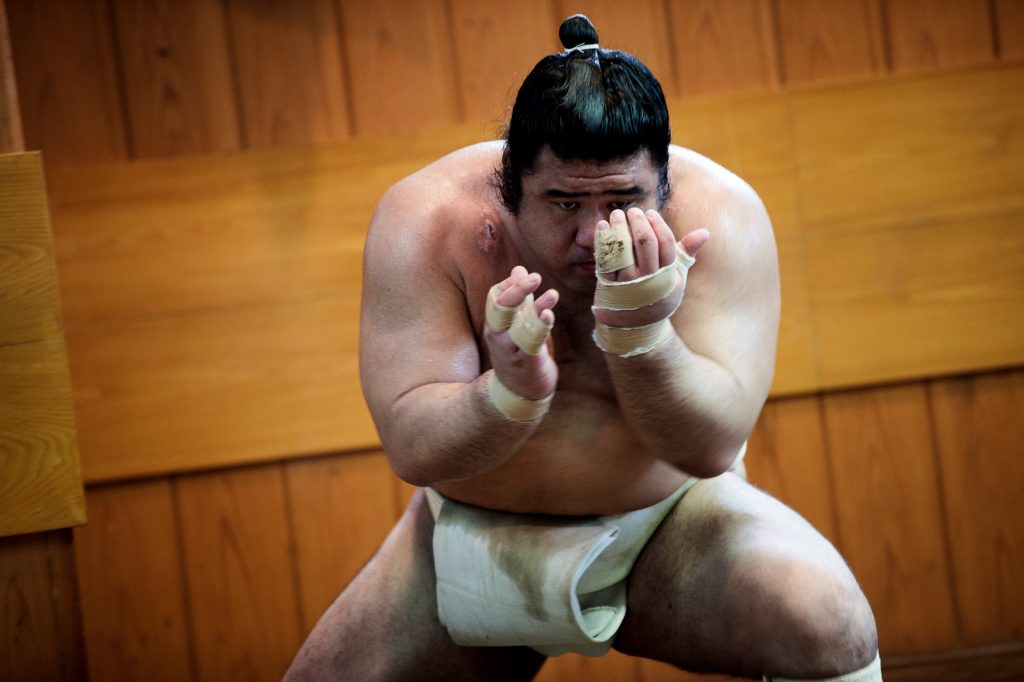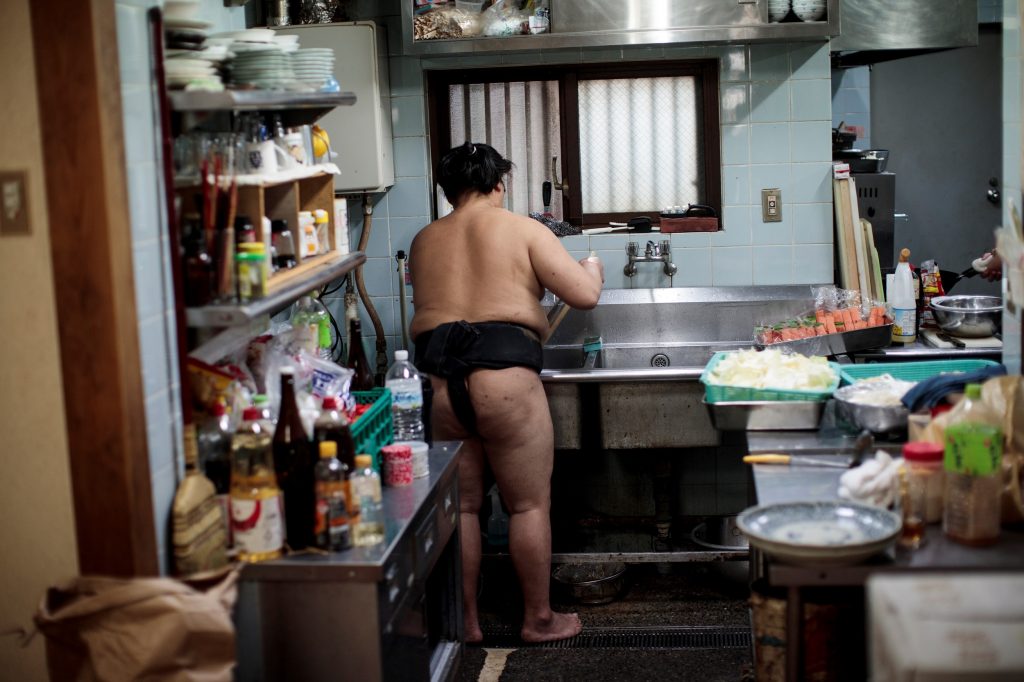





AFP, Tokyo
The quintessentially Japanese sport of sumo stops the country during the six big tournaments per year, with millions glued to the live action on TV.
Here are five key facts about the roly-poly sport which dates back centuries, has links to the Shinto religion and plays a central role in Japanese culture.
Sumo wrestlers squeeze their bulky frames into a mawashi, which looks like a baby’s nappy or diaper but is actually carefully designed sportswear. It is the only thing worn in the ring and also allows wrestlers to grip their opponent as they grapple.
The belts can be more than nine meters long, made from cotton when training and silk for official tournaments or “bashos”.
To slip into the belt, the naked wrestler first passes the mawashi between his legs. Then, with the help of assistants, he spins around so it fits snugly around the waist.
It must be tightly tied at the back, both to ensure it stays on but perhaps more importantly to prevent opponents from being able to dig their fingers too far down in the belt, giving them a more solid grip.
The winner is the wrestler who manages to shove his opponent out of the dohyo, the sacred clay ring 4.55 meters in diameter. The other way of winning is to throw the opponent so that part of his body other than his feet touches the floor.
A bout is steeped in Japanese traditions rooted in the Shinto religion, starting with wrestlers rinsing their mouths with purifying water and the sprinkling of salt before each match.
The contest begins with the bone-shuddering “tachi-ai” where the two wrestlers come together in a noisy clash of flesh -- and frequently heads.
This is considered the most important part of the bout -- “if you fail in the tachi-ai, you have an 80 percent chance of losing. You have to work hard on it,” Georgia-born sumo star Tsuyoshi Tochinoshin explained to AFP.
Slapping is permitted to the body and the face but hair-pulling and punching are strictly forbidden. Only the horizontal portion of the belt can be used as leverage.
It is technically possible to dodge a collision in the hope of forcing an opponent to topple over under his own weight, but this tactic is frowned upon.
While it is true that the vast majority of wrestlers are enormous, there can be a huge difference in weight – a 200-kilo fighter could easily lose to a 120-kilo opponent.
The dohyo is considered a sacred space and women, seen as “impure”, are banned from entering. This reached farcical lengths in 2018 when female medics rushed to help an official who collapsed in the ring, only to be shooed away.
If women enter the ring, it has to be “re-purifed” with copious quantities of salt. The head of the sumo association Hakkaku did apologise to the medics in 2018, but accusations of sexism remain.
Sumo has also been dogged by multiple scandals in recent years including allegations of bullying, illegal betting and links to organized crime.
Throughout their careers, wrestlers are housed in so-called “stables” run by a stablemaster under strict rules and a fierce hierarchy.
Trainee wrestlers sleep in a large dormitory on tatami mats, have to carry out a host of domestic chores and effectively act as servants to the more senior sumo professionals.
There is a brutal training routine, fueled by gargantuan portions of chankonabe, a calorific stew designed to pile on the pounds.
There remains a debate in sumo over which is most important: the “shin” (heart or spirit), the “gi” (technique) and the “tai” (physical force) but Tochinoshin is in no doubt -- “it’s the heart,” he exclaims immediately.
Experts often claim to be able to predict who will win from the pre-bout rituals of stomping around the ring and eyeballing the adversary.
“In a fight between two opponents of equal strength, the only thing that can make the difference... is their moral energy,” wrote Kirishima, a well respected fighter who reached the rank of ozeki, in his 1996 memoirs.